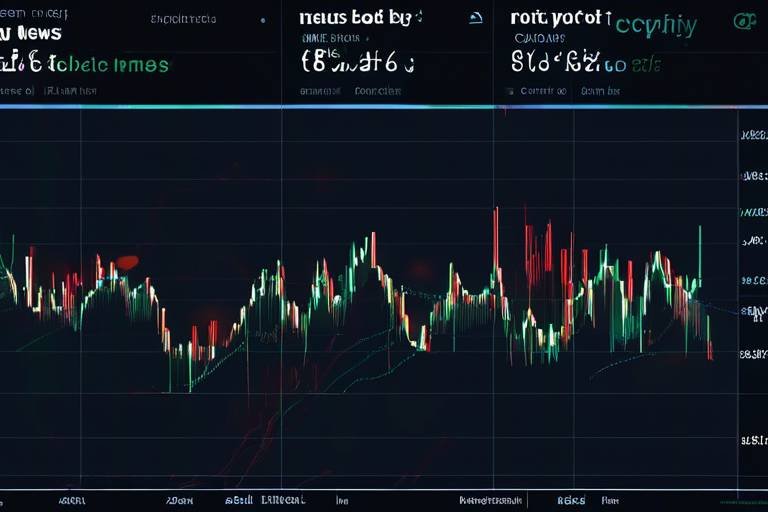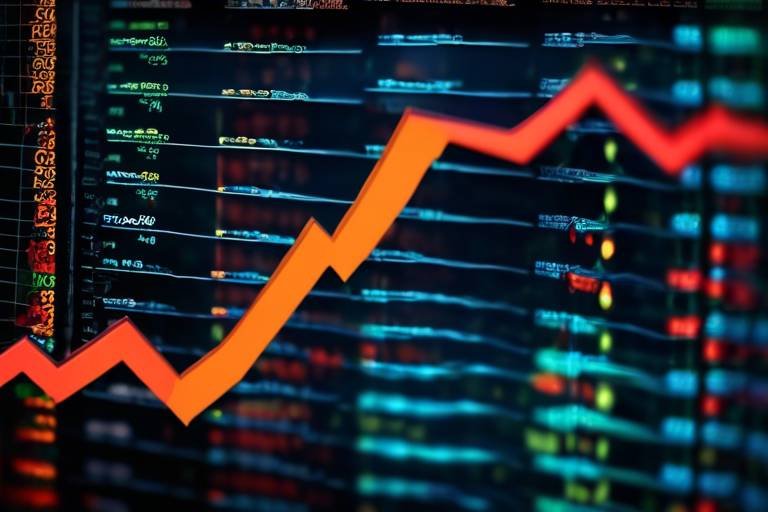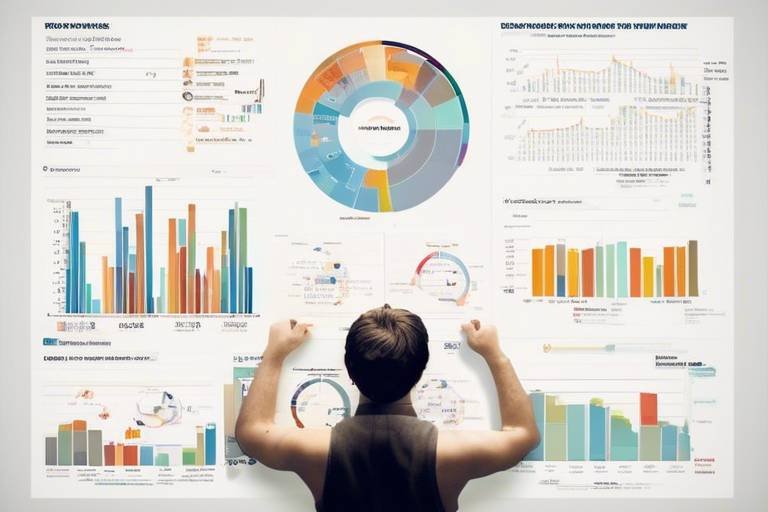The Role of Economic Indicators in Shaping Market Behavior
Economic indicators serve as the compass guiding investors through the often turbulent waters of market behavior. Think of these indicators as the pulse of the economy, giving us vital signs about its health and direction. They are essential tools for anyone looking to navigate the complex world of finance, as they provide insights into the economic performance of a country. Understanding these indicators is not just for economists or financial analysts; it's for anyone who wants to make informed decisions about their investments.
When we talk about economic indicators, we're referring to a variety of statistics that can reveal a lot about the current state and future prospects of the economy. For instance, indicators like the unemployment rate, inflation rate, and Gross Domestic Product (GDP) growth are commonly referenced. However, the real magic happens when we start to connect the dots between these indicators and market trends. Just as a weather forecast can help you decide whether to carry an umbrella or wear sunglasses, economic indicators can help investors gauge whether to buy, hold, or sell their assets.
But why should we care about these indicators in the first place? Well, imagine you're planning a road trip. Wouldn't you want to know if there are roadblocks ahead or if the weather is going to be clear? Similarly, economic indicators provide a roadmap for investors, helping them anticipate market movements and adjust their strategies accordingly. By monitoring these indicators, investors can make more informed decisions, potentially maximizing their returns while minimizing risks.
Furthermore, the interconnectedness of these indicators means that a change in one can lead to a ripple effect across the market. For example, if consumer confidence dips, it can lead to decreased spending, which in turn may affect corporate profits and stock prices. This is where the concept of leading and lagging indicators comes into play. Leading indicators can forecast future economic activity, while lagging indicators confirm trends after they've occurred. Understanding the difference between these two types can significantly enhance an investor's strategy.
In conclusion, economic indicators are not just numbers on a report; they are powerful tools that shape market behavior. By staying informed about these indicators, investors can better navigate the financial landscape, making decisions that are not only timely but also strategically sound. As we delve deeper into the specifics of these indicators, we will uncover how they can influence market trends and investor decisions, ultimately impacting the overall economic health.
- What are economic indicators? Economic indicators are statistics that provide insights into the economic performance of a country, helping investors make informed decisions.
- What is the difference between leading and lagging indicators? Leading indicators predict future economic activity, while lagging indicators confirm trends after they have occurred.
- Why are economic indicators important for investors? They help investors gauge market conditions, anticipate changes, and adjust their investment strategies accordingly.
- How can I keep track of economic indicators? Investors can follow economic reports released by government agencies, financial news outlets, and economic research organizations.

Understanding Economic Indicators
Economic indicators serve as the heartbeat of a nation's economy, providing critical insights that help us gauge its overall health and performance. Think of these indicators as the weather forecasts for the economy; just as a meteorologist uses data to predict weather patterns, economists analyze these indicators to forecast economic trends. They come in various forms and can be categorized into three main types: leading, lagging, and coincident indicators. Each type plays a unique role in shaping market behavior, influencing investor decisions, and guiding policymakers.
Leading indicators are like early warning signals, offering hints about future economic activity. For instance, if you notice a rise in building permits, it often suggests that construction activity will increase, signaling a potential economic upswing. Conversely, lagging indicators confirm trends after they occur, such as the unemployment rate or GDP growth. These indicators provide a retrospective view, helping analysts understand what has happened in the economy. Coincident indicators, on the other hand, move in tandem with the economy, giving real-time insights into current economic conditions.
To illustrate the importance of these indicators, consider the following table that summarizes their characteristics:
| Type of Indicator | Definition | Examples |
|---|---|---|
| Leading Indicators | Predict future economic activity | Stock market performance, consumer sentiment |
| Lagging Indicators | Confirm trends after they occur | Unemployment rate, GDP growth |
| Coincident Indicators | Move with the economy | Employment levels, retail sales |
Understanding these indicators is crucial for anyone looking to navigate the complex waters of the financial markets. Whether you're an investor trying to make informed decisions or a policymaker aiming to steer the economy in the right direction, keeping an eye on these indicators can provide valuable insights. They not only help in predicting economic trends but also enable us to react proactively rather than reactively, which is key in today's fast-paced economic landscape.

Leading vs. Lagging Indicators
When diving into the world of economic indicators, it’s crucial to understand the distinction between leading and lagging indicators. These two categories serve different purposes and provide unique insights into market behavior and economic health. Think of leading indicators as the crystal ball of the economy; they offer a glimpse into what might happen in the future. On the other hand, lagging indicators are like a rearview mirror, reflecting what has already transpired. This difference is essential for investors and analysts alike, as it shapes their strategies and decisions.
Leading indicators are proactive; they signal potential changes before they happen. For instance, if consumer confidence is on the rise, it often suggests that spending will increase, which can lead to economic growth. Conversely, lagging indicators confirm trends only after they have occurred. For example, a decrease in unemployment rates might indicate that the economy has already improved, rather than predicting future growth.
To illustrate this further, consider the following table that highlights some common leading and lagging indicators:
| Type | Indicator | Description |
|---|---|---|
| Leading | Stock Market Performance | Often reflects investor sentiment and can predict future economic activity. |
| Leading | Consumer Confidence Index | Measures how optimistic consumers feel about the economy, influencing spending. |
| Lagging | Unemployment Rate | Confirms trends in the labor market, reflecting economic conditions after changes occur. |
| Lagging | Gross Domestic Product (GDP) | Indicates the overall economic performance over a specific period, confirming past growth or decline. |
Understanding these indicators is not just academic; it has real-world implications for investment strategies. For example, an investor might look at leading indicators to forecast potential market movements and make decisions accordingly. If leading indicators suggest an upcoming economic expansion, they might invest in stocks or sectors that typically benefit from growth. On the flip side, if lagging indicators are showing signs of economic downturn, investors might shift their portfolios to minimize risk.
In summary, knowing the difference between leading and lagging indicators is like having a roadmap for navigating the economic landscape. By leveraging this knowledge, investors can make more informed decisions, potentially leading to better outcomes in their financial endeavors.

Examples of Leading Indicators
Leading indicators play a crucial role in forecasting economic trends, acting like a crystal ball for investors and policymakers alike. These indicators are the early birds that signal potential changes in the economy before they actually happen. By analyzing these indicators, one can gain valuable insights into where the economy might be headed, which is essential for making informed investment decisions. For instance, the performance of the stock market and consumer sentiment are two prominent examples of leading indicators that can significantly influence market behavior.
One of the most telling leading indicators is the Consumer Confidence Index (CCI). This index measures how optimistic or pessimistic consumers are regarding their financial situation and the overall economy. When consumers feel confident, they are more likely to spend money, which in turn can stimulate economic growth. A high CCI often correlates with increased consumer spending, which can lead to a bullish market sentiment. Conversely, if the CCI dips, it may indicate a looming recession, causing investors to pull back. For instance, during the financial crisis of 2008, a significant drop in the CCI foreshadowed the economic downturn that followed.
Another important leading indicator is manufacturing activity. The health of the manufacturing sector can provide early signs of economic momentum. When manufacturing output is on the rise, it often suggests that businesses are anticipating increased demand for their products, which can lead to hiring, investment, and ultimately, economic expansion. On the other hand, a decline in manufacturing activity can signal an impending slowdown. For example, the Purchasing Managers' Index (PMI) is a key measure of manufacturing activity that can predict economic trends based on surveys of purchasing managers. A PMI above 50 indicates expansion, while a figure below 50 suggests contraction.
To summarize, leading indicators like the Consumer Confidence Index and manufacturing activity not only provide insights into current economic conditions but also help forecast future trends. Investors who pay close attention to these indicators can position themselves strategically in the market, capitalizing on potential growth opportunities or safeguarding against downturns. Understanding these indicators is akin to having a map in uncharted territory; it can guide you toward safer shores or lucrative ventures.

Consumer Confidence Index
The Consumer Confidence Index (CCI) is not just a number; it’s a pulse check on the economy, reflecting how optimistic consumers feel about their financial situation and the overall economic landscape. When people feel good about their prospects, they tend to spend more, which in turn fuels economic growth. Conversely, when confidence dips, consumers tighten their belts, leading to a ripple effect that can slow down economic activity.
So, how is this index calculated? The CCI is derived from surveys conducted by the Conference Board, which ask consumers about their current financial conditions and their expectations for the next six months. The responses are then compiled into a single index number, where a score above 100 indicates optimism and below 100 indicates pessimism. This simple yet powerful metric can serve as a leading indicator of economic activity, providing invaluable insights for investors and policymakers alike.
For instance, a rising CCI suggests that consumers are feeling more secure in their jobs and are likely to increase spending. This uptick can lead to higher corporate earnings, which often results in a bullish stock market. On the other hand, a declining CCI may signal that consumers are worried about job security or rising prices, prompting them to cut back on spending. This reduction can lead to a slowdown in economic growth, affecting everything from retail sales to employment rates.
Moreover, the CCI can serve as an early warning system for potential economic downturns. If the index shows a consistent decline over several months, it may be time for investors to reassess their portfolios and consider defensive strategies. This is where understanding the CCI becomes crucial for making informed investment decisions.
In summary, the Consumer Confidence Index is a critical barometer of economic health. By keeping an eye on this index, investors can gain a better understanding of consumer behavior and its potential impact on market trends. As the saying goes, “When consumers are confident, the economy thrives.” So, the next time you hear about the CCI, remember that it’s more than just statistics; it’s a reflection of our collective economic mood.
- What does a high Consumer Confidence Index indicate? A high CCI indicates that consumers are feeling optimistic about their financial situation and are likely to spend more, which can boost economic growth.
- How often is the Consumer Confidence Index released? The CCI is typically released monthly, providing regular updates on consumer sentiment.
- Can the Consumer Confidence Index predict economic recessions? While not foolproof, a significant and sustained decline in the CCI can serve as an early warning sign of potential economic trouble.

Manufacturing Activity
Manufacturing activity serves as a critical leading indicator in the economic landscape, offering a glimpse into the health of the economy. When we talk about manufacturing, we're not just discussing factories and assembly lines; we're delving into the very heartbeat of economic growth. Think of manufacturing activity as a barometer for future economic performance. When manufacturing is thriving, it typically signals that businesses are confident, consumers are spending, and the economy is poised for expansion. Conversely, a downturn in manufacturing can foreshadow economic challenges, leading to cautious investor behavior and a slowdown in market activity.
One key metric within manufacturing activity is the Purchasing Managers' Index (PMI), which surveys business leaders in the manufacturing sector to gauge their outlook on production levels, new orders, and employment. A PMI above 50 indicates expansion, while a figure below 50 suggests contraction. This simple yet powerful indicator can sway investor sentiment and influence market trends significantly. For instance, if the PMI shows consistent growth, investors may feel emboldened to invest in stocks, anticipating a robust economic environment. On the other hand, a declining PMI can trigger a wave of selling as investors reassess their positions.
Moreover, manufacturing activity doesn't exist in a vacuum. It is intricately linked to other economic indicators, such as employment rates and consumer spending. When manufacturers ramp up production, they often require more workers, which can lead to a drop in unemployment rates. This, in turn, boosts consumer confidence as more people have jobs and disposable income to spend. Additionally, robust manufacturing output can lead to increased exports, further stimulating economic growth. The interconnectedness of these factors highlights why monitoring manufacturing activity is essential for investors and analysts alike.
To illustrate the impact of manufacturing activity on the economy, consider the following table that outlines the relationship between manufacturing output, employment rates, and consumer confidence:
| Year | Manufacturing Output (Index) | Employment Rate (%) | Consumer Confidence Index |
|---|---|---|---|
| 2020 | 45 | 8.5 | 85 |
| 2021 | 55 | 6.0 | 95 |
| 2022 | 60 | 5.0 | 105 |
| 2023 | 62 | 4.5 | 110 |
This table illustrates how a rise in manufacturing output correlates with lower unemployment rates and higher consumer confidence. It’s a classic case of cause and effect, where a thriving manufacturing sector can lead to a more robust economy.
In conclusion, keeping a close eye on manufacturing activity is essential for anyone looking to navigate the complexities of market behavior. Whether you're an investor, a business owner, or simply someone interested in economic trends, understanding how manufacturing impacts the broader economy can provide valuable insights. As the saying goes, "What’s good for manufacturing is good for the economy," and in today’s ever-changing market landscape, this couldn’t be more accurate.
- What is the Purchasing Managers' Index (PMI)?
The PMI is an economic indicator that measures the health of the manufacturing sector by surveying purchasing managers on their outlook for production, new orders, and employment.
- How does manufacturing activity affect employment rates?
Increased manufacturing activity often leads to higher demand for workers, resulting in lower unemployment rates as businesses hire more staff to meet production needs.
- Why is consumer confidence important in relation to manufacturing?
Consumer confidence can drive spending; when people feel optimistic about the economy, they are more likely to spend money, which benefits the manufacturing sector.

Examples of Lagging Indicators
When we talk about lagging indicators, we're diving into metrics that confirm trends after they've already occurred. Think of them as the rearview mirror of the economy; they show us where we've been rather than where we are headed. This can be particularly useful for investors looking to understand the overall health of the economy after major shifts have taken place. Let's explore some of the most significant lagging indicators that can shape market behavior.
One of the most commonly referenced lagging indicators is the unemployment rate. This statistic reflects the percentage of the labor force that is jobless and actively seeking employment. A rising unemployment rate often signals economic distress, as it indicates that businesses are either downsizing or failing to hire, leading to reduced consumer spending. Conversely, a falling unemployment rate can suggest a recovering economy, encouraging investor confidence.
Another critical lagging indicator is Gross Domestic Product (GDP) growth. GDP measures the total value of all goods and services produced over a specific time period. It’s a comprehensive snapshot of economic activity. Investors often look at GDP growth rates to gauge the performance of the economy. For instance, if GDP growth is consistently below expectations, it may lead to a bearish sentiment in the market, prompting investors to rethink their strategies.
In addition to unemployment rates and GDP, we also have corporate profits. This indicator reflects the financial health of companies and is essential in determining the overall economic climate. When corporate profits are high, it often leads to increased investment and hiring, which can positively influence the stock market. However, if profits are declining, it may signal trouble ahead, causing investors to pull back.
Let’s not forget about the Consumer Price Index (CPI), which tracks changes in the price level of a basket of consumer goods and services. While it can be seen as both a lagging and leading indicator, its role as a lagging indicator is significant when it comes to inflation trends. A rising CPI indicates that inflation is increasing, which can lead to higher interest rates, affecting borrowing and spending behaviors. This can create ripples in the market, influencing investor decisions.
To summarize, lagging indicators play a crucial role in understanding the economic landscape. They help investors confirm trends and make informed decisions based on historical data. Here’s a quick reference table to illustrate some key lagging indicators:
| Lagging Indicator | Description | Market Impact |
|---|---|---|
| Unemployment Rate | Percentage of the labor force that is unemployed. | High rates may indicate economic trouble, leading to decreased investor confidence. |
| Gross Domestic Product (GDP) | Total value of goods and services produced in a country. | Low GDP growth can trigger bearish market sentiment. |
| Corporate Profits | Net income of corporations. | Declining profits may lead to reduced investment and layoffs. |
| Consumer Price Index (CPI) | Measures changes in the price level of a basket of consumer goods. | Rising CPI can signal inflation, affecting interest rates and spending. |
In conclusion, while lagging indicators may not predict future market movements, they provide essential insights into the economic conditions that have already transpired. Investors who understand these metrics can better navigate market dynamics and make strategic decisions based on confirmed trends.

The Impact of Economic Reports
Economic reports are like the pulse of the financial world, providing critical information that can either pump up or deflate market enthusiasm. When these reports are released, they can create a ripple effect that reverberates through various sectors, influencing everything from stock prices to consumer spending. Imagine walking into a crowded room where everyone is buzzing about the latest news; that's the financial market reacting to economic data. Investors closely monitor these reports, as they provide insights into the health of the economy and can significantly affect investment strategies.
One of the most anticipated economic reports is the monthly employment statistics. This report not only reveals the number of jobs added or lost but also gives insights into wage growth and labor market trends. A strong employment report can lead to a surge in investor confidence, while a disappointing one can trigger panic selling. For instance, if the unemployment rate drops significantly, it often signals a robust economy, prompting investors to buy stocks in anticipation of higher corporate earnings.
Another crucial report is the Consumer Price Index (CPI), which measures inflation. Inflation can be a double-edged sword; while a little inflation is generally seen as a sign of a growing economy, too much can erode purchasing power and lead to higher interest rates. Investors need to keep a keen eye on inflation data, as it can influence the Federal Reserve's monetary policy decisions. If inflation is rising faster than expected, the Fed may choose to increase interest rates, which can have a cascading effect on market behavior.
In addition to employment and inflation reports, other economic indicators like Gross Domestic Product (GDP) growth, retail sales, and manufacturing output also play significant roles. Each of these reports provides a piece of the economic puzzle, helping investors gauge whether the economy is on an upward trajectory or facing headwinds. For example, a strong GDP growth report can boost market sentiment, while weak retail sales can raise concerns about consumer confidence and spending.
| Economic Report | Impact on Market |
|---|---|
| Employment Statistics | Strong figures can boost stocks; weak figures may cause declines. |
| Consumer Price Index (CPI) | High inflation can lead to interest rate hikes, affecting stock prices. |
| Gross Domestic Product (GDP) | Positive growth can enhance investor confidence; negative growth may lead to sell-offs. |
| Retail Sales | Strong sales indicate consumer confidence, boosting market sentiment. |
| Manufacturing Output | Increased output suggests economic strength, positively impacting stocks. |
Ultimately, the interpretation of these reports is just as important as the data itself. Investors must consider the context, such as previous trends and market conditions, to make informed decisions. For example, if an economic report shows a slight increase in unemployment but is still below historical averages, investors might view this as a temporary blip rather than a sign of a looming recession. On the other hand, if multiple reports indicate a downturn, it may trigger a more cautious approach from investors.
In conclusion, economic reports are vital to understanding market dynamics. They offer a snapshot of the economy’s health, guiding investor sentiment and market behavior. By keeping an eye on these reports and understanding their implications, investors can navigate the complexities of the financial landscape more effectively.
- What are economic indicators? Economic indicators are statistics that provide insights into the economic performance of a country, such as employment rates, inflation, and GDP growth.
- Why are economic reports important? They help investors understand the current state of the economy and make informed decisions regarding investments.
- How do leading and lagging indicators differ? Leading indicators predict future economic activity, while lagging indicators confirm trends after they occur.
- What is the Consumer Confidence Index? It's a leading indicator that measures consumer optimism about the economy, influencing spending behaviors and market trends.

Market Reactions to Economic Data
When economic data is released, it often feels like the stock market is a live wire, buzzing with energy and anticipation. Investors, traders, and analysts are all on high alert, ready to react to the latest numbers that could shift the market's direction. But why does this data elicit such strong responses? Well, it's all about the expectations and the uncertainty that surround economic indicators. As these reports come out, they can either confirm what everyone already suspected or throw a curveball that catches the market off guard.
For instance, when the employment report is released, detailing the number of jobs added or lost in a given month, the market's reaction can be immediate. If the report shows a surge in job creation, it signals a robust economy, leading to a spike in stock prices as investors rush to buy in anticipation of future growth. Conversely, if the data reveals a significant drop in employment, panic can ensue. Stocks may plummet as investors fear a recession is looming. This behavior is not just limited to employment data; it applies to a range of economic reports, including inflation rates, consumer spending, and manufacturing output.
Consider this: the Consumer Price Index (CPI) is released, showing a higher-than-expected inflation rate. Instantly, investors may fear that the central bank will raise interest rates to combat inflation, which could slow down economic growth. As a result, they might sell off stocks, leading to a market downturn. On the other hand, if the CPI indicates stable prices, it could encourage buying, as investors feel more secure about future profits.
To illustrate the volatility of market reactions, let's take a look at a table that summarizes some notable instances of market responses to economic data releases:
| Date | Economic Data Released | Market Reaction |
|---|---|---|
| March 2023 | Non-Farm Payrolls Report | Stocks surged 2% on strong job growth. |
| April 2023 | Consumer Confidence Index | Market dipped 1.5% due to declining consumer sentiment. |
| June 2023 | GDP Growth Rate | Stocks rallied 3% on better-than-expected growth. |
| August 2023 | Inflation Rate | Market fell 2% as inflation rose unexpectedly. |
This table highlights how different economic reports can lead to varied market responses, often dictated by the context of the data and the prevailing market sentiment. The reactions can be swift and sometimes exaggerated, as traders often operate on the principle of buying the rumor and selling the news. This means that they may anticipate certain outcomes and adjust their positions before the data is even released, leading to a rush of buying or selling once the actual numbers are out.
In summary, understanding market reactions to economic data is crucial for any investor looking to navigate the often-turbulent waters of the financial markets. By keeping an eye on these indicators and their potential impacts, investors can make more informed decisions that align with their financial goals. So, the next time you hear about a significant economic report, remember: the market is watching, and its reaction can set the tone for days or even weeks to come.
- What are economic indicators? Economic indicators are statistics that provide insights into the economic performance of a country, helping investors make informed decisions.
- Why do markets react to economic data? Markets react to economic data because these reports can indicate future economic conditions, influencing investor sentiment and market trends.
- What is the difference between leading and lagging indicators? Leading indicators can predict future economic activity, while lagging indicators confirm trends after they occur.
- How can I interpret economic data releases? By analyzing the context of the data, comparing it to expectations, and observing market reactions, you can gain insights into potential market movements.

Interpreting Economic Trends
Interpreting economic trends is akin to reading a complex novel where every chapter builds on the last, revealing deeper insights into the storyline of our economy. Investors, analysts, and even everyday consumers must understand these trends to navigate the financial landscape effectively. But how do we make sense of the myriad of data available? It starts with recognizing that economic indicators don’t exist in isolation; they are part of a larger narrative that reflects the health and direction of the economy.
To grasp economic trends, one must first consider the context in which these indicators are presented. For instance, a rising unemployment rate might initially seem alarming, but when paired with data showing robust job creation in other sectors, it could indicate a transition phase rather than a downturn. This interplay of data is crucial—just like a puzzle, each piece contributes to the overall picture.
Moreover, understanding the cyclical nature of the economy can enhance our interpretation of trends. The economy moves in cycles: expansion, peak, contraction, and trough. By identifying which phase the economy is currently in, investors can better predict how various indicators will behave. For example, during an expansion phase, one might expect to see rising consumer spending, increased manufacturing output, and a general sense of optimism. Conversely, during a contraction phase, indicators like consumer confidence and manufacturing activity may decline.
Another important aspect of interpreting economic trends is recognizing the influence of external factors. Global events, policy changes, and technological advancements can all impact economic indicators. For example, a sudden geopolitical crisis might lead to fluctuations in oil prices, which in turn can affect inflation rates and consumer spending. This interconnectedness means that investors must stay informed about not only domestic indicators but also international developments.
Additionally, it’s vital to differentiate between short-term fluctuations and long-term trends. Economic data can be volatile, influenced by seasonal changes or temporary events. Therefore, it’s essential to look at moving averages or longer-term data to gain a clearer picture. For instance, while a sudden spike in inflation might cause panic, examining a longer-term trend can reveal whether it’s a temporary blip or a sign of deeper issues.
In summary, interpreting economic trends requires a multifaceted approach that considers context, cyclical phases, external influences, and the distinction between short-term and long-term data. By developing a keen eye for these nuances, investors can make more informed decisions, ultimately leading to better financial outcomes. The economy, much like a living organism, is constantly evolving, and understanding its trends is key to thriving in the ever-changing market landscape.
- What are economic indicators? Economic indicators are statistics that provide insights into the economic performance of a country, helping analysts gauge its health and direction.
- How do leading indicators differ from lagging indicators? Leading indicators predict future economic activity, while lagging indicators confirm trends that have already occurred.
- Why is it important to interpret economic trends? Interpreting economic trends allows investors and policymakers to make informed decisions based on the current economic landscape.
- How can external factors affect economic indicators? External factors such as geopolitical events, natural disasters, and technological advancements can significantly influence economic indicators and market behavior.
Frequently Asked Questions
- What are economic indicators?
Economic indicators are vital statistics that help gauge the economic performance of a country. They provide insights into various aspects of the economy, such as growth, inflation, and employment rates, allowing investors and policymakers to make informed decisions.
- What is the difference between leading and lagging indicators?
Leading indicators are metrics that can predict future economic activity, while lagging indicators confirm trends after they have occurred. For instance, stock market performance is a leading indicator, suggesting future economic growth, whereas unemployment rates are lagging indicators, reflecting past economic conditions.
- Can you give examples of leading indicators?
Sure! Some common leading indicators include the Consumer Confidence Index, which measures consumer optimism, and manufacturing activity, which signals economic momentum. These indicators can provide valuable insights into how the market might behave in the near future.
- What are some notable lagging indicators?
Notable lagging indicators include GDP growth and unemployment rates. These metrics are essential for understanding the current state of the economy, as they confirm trends that have already taken place, helping investors assess overall market conditions.
- How do economic reports affect market behavior?
Economic reports, such as employment statistics and inflation data, can significantly influence market behavior. Investors closely monitor these reports and often react quickly to the information they provide, leading to immediate and sometimes volatile market movements.
- What should investors look for when interpreting economic trends?
Investors should analyze the broader economic trends revealed by indicators, considering factors like historical data, current market conditions, and potential future impacts. This understanding can help them make strategic decisions and better navigate the complexities of the market.



















